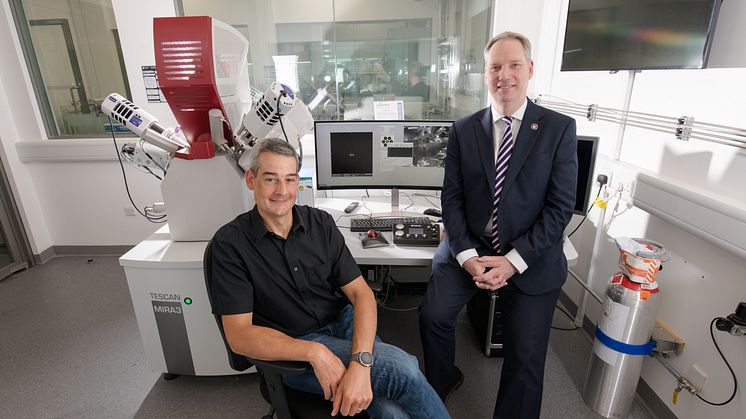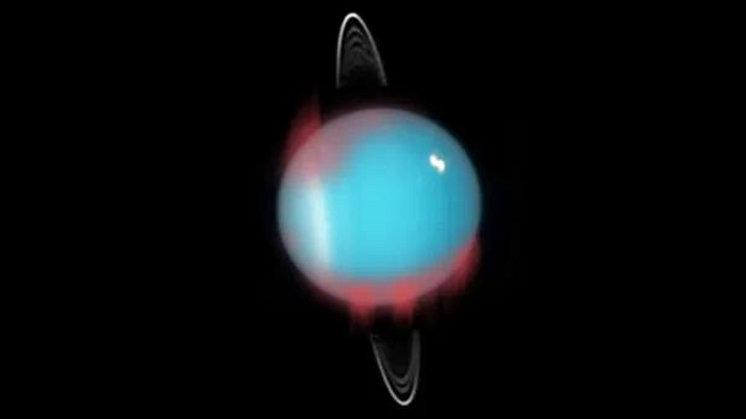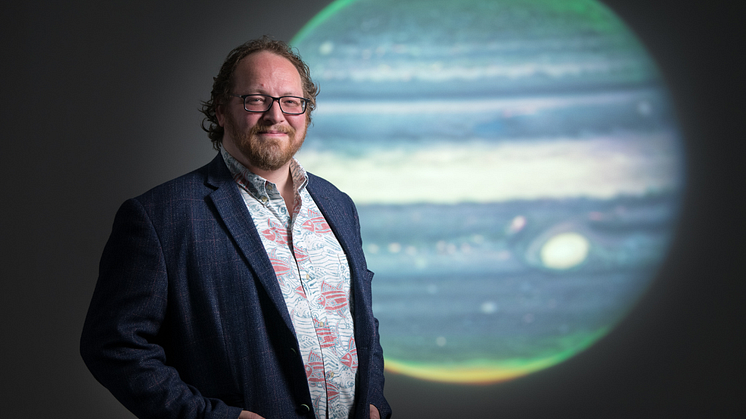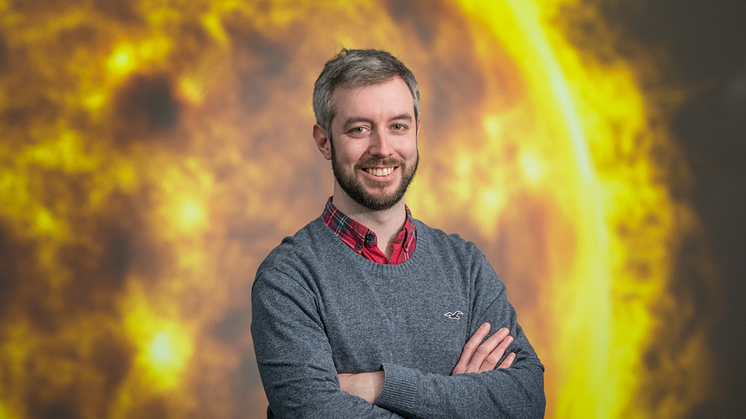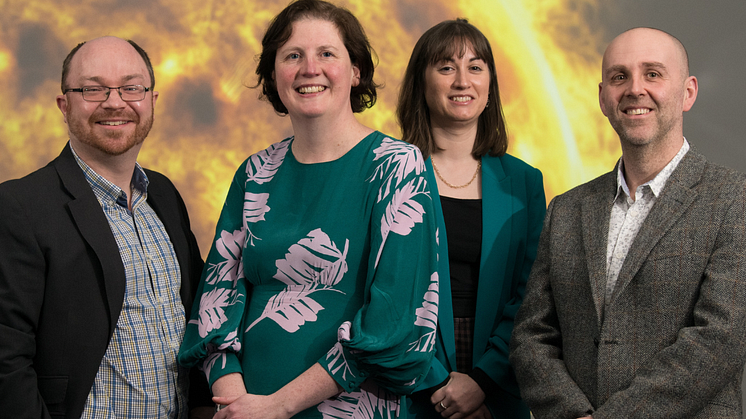
Press release -
£1.29 million funding boost for solar scientists
Scientists from Northumbria University’s world-leading Solar and Space Physics research group have been awarded more than £1 million to carry out research which will further our understanding of the Sun, and its impact on Earth.
Researchers have received a £1.29 million grant from the UK government’s Science and Technology Facilities Council(STFC) to fund four research projects, each exploring a different element of the Sun’s activity and the Sun-Earth connection.
They include the movement of particles from solar flares, the speed and movement of solar winds, the processes that heat the Sun’s outer atmosphere to millions of degrees Celsius, and the dynamics of the radiation belts surrounding Earth.
Professor James McLaughlin heads up Northumbria University’s Solar and Space Physics research group and is lead investigator for one of the STFC-funded projects – The fundamental physics of time-dependent magnetic reconnection with a specific interest in the applicability to Quasi-Periodic Pulsations.
His research will focus on the process known as magnetic reconnection – when magnetic lines within the outermost part of the Sun's atmosphere, the solar corona, become twisted, break apart, then reconnect.
This results in a sudden release of electromagnetic energy in the form of a solar flare and a coronal mass ejection – an explosive acceleration of plasma away from the Sun towards Earth.
The project aims to develop our understanding of reconnection, including quasi-periodic pulsations – time variations in the energy released during a flare, which are not understood but which could tell scientists much about the properties of the flare.
Professor McLaughlin and colleagues will use high performance computing to run numerical simulations – using existing data gathered from past solar flares to better understand the process taking place.
Speaking about his research, Professor McLaughlin said: “When magnetic lines become twisted, they can store energy like an elastic band. If the lines break and reconnect that energy is released. This is a very common occurrence in the solar corona and also happens in the atmospheres of other magnetically-active stars.
“When reconnection occurs that stored energy is transformed into other forms of energy – this could be a solar flare or coronal mass ejection, which in turn results in space weather which we experience on earth in the form of solar radiation or geomagnetic storms.
“One of the focuses of our research group is predicting space weather. To do that we need to understand its origins and discovering more about what triggers solar flares will allow us to do that.”
Space weather from the Sun can pose a significant risk to the technologies we rely on in daily life and those designing such infrastructures need to take space weather into account when designing robust systems.
These risks are recorded in the UK government’s national risk register with severe space weather recognised as a significant risk. The long term findings of these new Northumbria University projects will help the UK increase its preparedness and resilience to possible severe space weather events in the future.
Another of the projects funded through the STFC grant will explore the way in which high energy particles, such as electrons, are distributed when released from a solar flare.
Led by Dr Natasha Jeffrey, the Determining Solar Flare Hard X-ray Directivity using Stereoscopic Observations with Solar Orbiter/STIX project aims to reveal more about the conditions that produce high energy particles in solar flares.
Up until now it has not been possible to routinely measure the angular distribution of energetic electrons accelerated in a solar flare.
However, because electrons release X-rays as they travel, scientists are now able to use data from the Spectrometer Telescope for Imaging X-rays (STIX), situated on board the European Space Agency’s Solar Orbiter satellite, to determine this information using stereoscopic observations. This is where the flare is viewed from two different observer viewpoints, using STIX and other X-ray spacecraft situated at Earth.
And with the Sun currently entering its solar maximum – the period of greatest solar activity during the star’s 11-year solar cycle – there will be a higher number of flares to observe, making this the optimum time for such research.
Speaking about the project, Dr Jeffrey said: “This project will advance our understanding of solar flare particle acceleration and transport by investigating the angular distribution, or directivity, of flare-accelerated electrons.
“Up until now the directivity of the particles has been a missing diagnostic in our understanding of the acceleration environment of solar flares, but thanks to the data we can now obtain from STIX and by comparing that data with state-of-the-art electron and X-ray computer simulations, we can constrain the conditions producing energetic particles in flares.”
A further two projects have also received funding through the STFC grant. Professor Jonathan Rae will lead the Using machine learning to determine and understand the underlying states of radiation belt electrons project.
Using machine learning and artificial intelligence, this research aims to identify and understand the underlying states of radiation belt electrons, and how and why those states evolve in time and space.
Professor Clare Watt leads the fourth project – Understanding generation of whistler-mode waves in the magnetosphere.
Whistler-mode waves are one of the most intense electromagnetic waves in the planetary magnetospheres and are responsible for energetic electron losses into the atmosphere.
Professor Watt’s research will also investigate a new paradigm for whistler-mode growth using machine learning applied to drifting electron energy flux.
Between them, the four projects will allow scientists not only to discover more about the physics of the Sun, the Sun-Earth connection, Earth’s magnetosphere and radiation belts, but how stars behave more generally.
The Sun is made of ionised gas, known as plasma, which is threaded by a strong magnetic field. With magnetised plasmas common throughout the Universe, the research will also advance scientific understanding across multiple research communities.
Speaking about the significance of the STFC grant, Professor James McLaughlin said: “We are delighted to be working with STFC on these transformative, ground-breaking research projects. The Solar and Space Physics research group demonstrates international leadership across theory, numerical modelling, observations of solar and space plasma, data intensive science, and space-related hardware, and this funding award supports those strengths.
“We are particularly excited about our research contributing to the prediction of Space Weather, as well as training people in high performance computing and in machine learning.
“Machine Learning is a particular strength of the Group, and synergises with our STFC-funded NUdata Centre for Doctoral Training in Data Intensive Science.”
The UK Space sector is growing rapidly, with the North East in particular experiencing a surge in investment in space technology and skills. Northumbria is capitalising on this with UK Government investment in its new Northumbria Space Technology Laboratory.
Prospective students can find out more about this exciting research area on Northumbria University’s Physics with Astrophysics BSc (Hons) degree course, which includes learning about space weather, artificial intelligence and the latest astrophysics research.
Solar and Space Physics is an academic peak of excellence at Northumbria University. Find out more about the work of academics carrying out research in this field.
Topics
Categories
UNIVERSITY OF THE YEAR 2022 (Times Higher Education Awards)
Northumbria is a research-intensive university that unlocks potential for all, changing lives regionally, nationally and internationally. Find out more about us at www.northumbria.ac.uk
--- Please contact media.communications@northumbria.ac.uk with any media enquiries or interview requests ---









